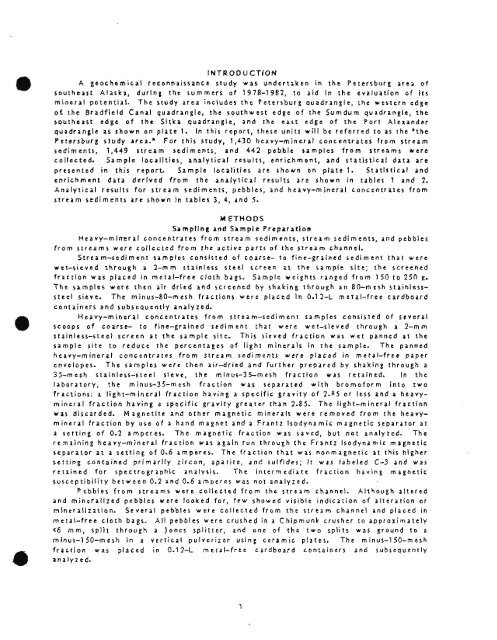mlnerrls library - Alaska Division of Geological & Geophysical Surveys
mlnerrls library - Alaska Division of Geological & Geophysical Surveys
mlnerrls library - Alaska Division of Geological & Geophysical Surveys
Create successful ePaper yourself
Turn your PDF publications into a flip-book with our unique Google optimized e-Paper software.
INTRODUCTION<br />
A geochemical reconnaissance study was undertaken in the Petersburg area <strong>of</strong><br />
southeast <strong>Alaska</strong>, during the summers <strong>of</strong> 1978-1982, to aid in the evaluation <strong>of</strong> its<br />
mineral potential. The study area includes the Pctcrsburg quadrangle, the western edge<br />
<strong>of</strong> the Bradfield Canal quadrangle, the southwest edge <strong>of</strong> the Sumdum quadrangle, the<br />
southeast edge <strong>of</strong> the Sitka quadrangle, and the east edge <strong>of</strong> the Port Alexander<br />
quadrangle as shown on plate 1. In this report, these units will be referred to as the "he<br />
Petersburg study arca.n For this study, 1,430 heavy-mineral concentrates from stream<br />
sediments, 1,449 stream sediments, and 442 pebble samples from streams were<br />
collected. Sample localities, analytical results, enrichment, and statistical data are<br />
presented in this report. Sample localities are shown on plate 1. Statistical and<br />
enrichment data derived from the analytical results arc shown in tables 1 and 2.<br />
Analytical results for stream sediments, pebbles, and heavy-mineral concentrates from<br />
stream sediments are shown in tables 3, 4, and 5.<br />
METHODS<br />
Sampling and Sample Preparation<br />
Heavy-mirtral concentrates from strtam $ediments, stream sediments, and pebbles<br />
fram streams wtre collected from the active parts <strong>of</strong> the stream channel.<br />
Stream-sediment samples consisted <strong>of</strong> coarse- to fine-grained sediment that were<br />
wet-sieved through a 2-mm stainless steel screen at the sample site; the screened<br />
fraction was placed in metal-free cloth bags. Sample weights ranged from 150 to 251) g.<br />
The samples were then air dried and screened by shaking through an 80-mesh stainltss-<br />
steel sieve. The minus-80-mesh fractions were plactd in 0.12-L metal-free cardboard<br />
containers and subsequently analyzed.<br />
Heavy-mineral concentrates from stream-sediment samples consisted <strong>of</strong> several<br />
scoops <strong>of</strong> coarse- to fine-grained sediment that were wet-sieved through a 2-mm<br />
stainless-steel screen at the sample site. This sieved fraction was wet panned at the<br />
sample site to reduce the percentages <strong>of</strong> light minerals in the sample. The panned<br />
heavy-mineral concentrates from stream sediments were placed in metal-free paper<br />
envelopes. The samples were then air-dried and further prepared by shaking through a<br />
35-mesh stainless-steel sieve, the minus-35-mesh fraction was retained. In the<br />
laboratory, the minus-35-mesh fraction was separated with brom<strong>of</strong>orm into two<br />
fractions: a light-mineral fraction having a specific gravity <strong>of</strong> 2.R5 or less and a hcavy-<br />
mineral fraction having a specific gravity greater than 2.$5. The light-mineral fraction<br />
was discarded. Magnetite and other magnetic minerals were removed from the heavy-<br />
mineral fraction by use <strong>of</strong> a hand magnet and a Frantz lsodynarnic magnetic separator at<br />
a setting <strong>of</strong> 0.2 amperes. The magnetic fraction was saved, but not analyzed. The<br />
remaining heavy-mineral fraction was again run through the Frantz lsodynamic magnetic<br />
separator at a setting <strong>of</strong> 0.6 amperes. The fraction that was nonmagnetic at this higher<br />
setting contained primarily zircon, apatite, and sulfides; it was labeled C-3 and was<br />
retained for spectrographic analysis. The intermediate fraction having magnetic<br />
susceptibility between 0.2 and 0.6 amperes was not analyzed.<br />
Pebbles from streams were collccttd from the strtam channel. Although alttrtd<br />
and mineralized pebbles were looked for, few showed visible indication <strong>of</strong> alteration or<br />
mineralization. Several pebbles wtre collccttd from the stream channel and plactd in<br />
metal-fret cloth bags. All pebbles were crushed in a Chipmunk crusher to approximately<br />
















